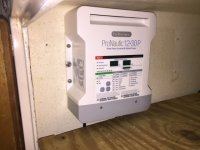You are really best off sizing wire for the Maximum current, (3% voltage drop @ 12 volts = 0.36 volts.) Considering that we are trying to get the most efficient use of our time and resources, you want to get the most voltage/current into those batteries.
There are two scenarios. One is you come back to your dock after a weekend out, and the batteries have been brought up to about 80% state of charge, by the outboard alternator. The batteries have to be topped off that last 20%. This is what the chargers which we get with our boats (typically a Guest 5-5-10 amps)
The other scenario--is closer to what Tom and Joyce use. They like to hang on the hook for days or weeks at a time. The charging is going to be mostly the outboard, but can be supplemented with a generator. I believe that Tom's 200 hp outboard puts out a theoretical 50 amps at WOT. We don't know exactly what the output is at his normal slower cruising speeds, nor do we know the exact amount available to charge batteries---especially if trolling. There is the amount needed to run the engine. Then there are the electronics, the refrigerator and another other appliances. There may be only 20 to 30 amps available.
What we do, is to force charge our 2 group 31 AGM batteries (about 110 amp hours each) from a portable charger, where we can put in 30 amps for a period of several hours. Then we stop charging when the charge rate drops to 3 to 5 amps. But it is that low amperage charging which tops off the battery last 20%. This takes considerable time. So we are often cycling our batteries between 50% to 80% state of charge. For example when cruising AK, we would stay at a marina every 3rd night if possible to top off the batteries, and get a hot shower (without steaming up the inside of the boat--alternate days were sponge baths)...
Overall my advice is to go with the heavier wire. Consider the effect of 10% voltage drop: At the Bulk phase of charging the charger is putting out 14.1 volts--but with 10% voltage drop, you are only getting 12.69 volts! That means that you are not really charging the battery--and it will take forever! Even with the 3% drop, the 14.1 becomes 13.67 volts. Enough to charge, but not at the most efficient rate. It would be good to check to see what the voltage is at the charger and the battery after the new battery and new charger is installed, with the present wiring. Then make a decision. It is very possible that your new charger will allow 14.8 volts, and then you are going to get a higher voltage at the battery.
I downloaded the manual for Tom's battery charger: great feature is that the output voltage and amperage is displayed, and there are good profiles. The "bad news" is that the manual, only gives the wire size up to 30 feet round trip run--and in that case it is #4. Interpolating, that it would be #2 for for a 40 foot run--and you have to round up--when using the wire size. #2 wire has a cross sectional surface are of 33.6 mm2 or 50% more than the #4 wire!
Also fuse the wire for the maximum current, at both ends--within 7" of the battery charger and 7" of the battery.
Also the best battery chargers have a temperature probe at the battery terminal, to avoid overcharging the battery. I have a Magnum inverter / charger on my RV which puts out 110 amps charging--the cables are only about 3 feet long, and are 00. There is a separate temperature probe and a voltage sense wire from the inverter charger to the battery bank of golf cart batteries.

